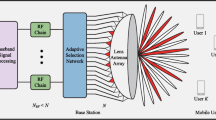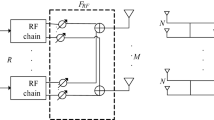Abstract
Massive multiple-input multiple-output (MIMO) technology obtains better transmission efficiency because of the number of antennas at transmitting end and receiving end increased up to a few hundred, but it will also limit the performance due to pilot contamination arise from interference among users. In order to get the pilot contamination problem in massive MIMO systems settled, an Ant Colony Optimization Pilot Assignment strategy is proposed. Firstly, it uses the interference path diagram among users according to the user's channel transmission characteristics. Secondly, it performs optimization iterations according to the idea of the ant colony optimization algorithm to find the optimum route with the least total interference among users. Furthermore, it performs pilot assignment to users according to the required path to obtain a pilot assignment scheme with the least interference among users. The simulation results prove that the proposed method can suppress the pilot contamination problem and improve the performance of communication system with advantage.










Similar content being viewed by others
References
Xia, X., Xu, K., Wang, Y., & Xu, Y. (2018). A 5G-enabling technology: Benefits, feasibility, and limitations of in-band full-duplex mMIMO. IEEE Vehicular Technology Magazine, 13(3), 81–90.
Xu, F., Wang, H., & Wang, H. (2020). Constellation coordination and pilot reuse for multi-cell large-scale MIMO systems. IET Communications, 14(2), 357–363.
Wu, C., & Shang, H. (2020). QoS-aware resource allocation for d2d communications. Journal of Northeast Electric Power University, 40(2), 89–95.
Wang, Q., Wei, M., & Zhu, Y. (2018). Channel estimation for multi-user massive MIMO systems based on compressive sensing with truncated-HOSVD. Journal of Information Hiding and Multimedia Signal Processing, 9(2), 423–431.
Özdogan, Ö., Björnson, E., & Zhang, J. (2019). Performance of cell-free massive MIMO with Rician fading and phase shifts. IEEE Transactions on Wireless Communications, 18(11), 5299–5315.
Sun, Z., & Yang, D. (2019). D2D radio resource allocation algorithm based on global fairness. Journal of Northeast Electric Power University, 39(1), 81–87.
Xia, X., Xu, K., Zhang, D., Xu, Y., & Wang, Y. (2017). Beam-domain full-duplex massive MIMO: Realizing co-time co-frequency uplink and downlink transmission in the cellular system. IEEE Transactions on Vehicular Technology, 66(10), 8845–8862.
Yu, S., Chen, S., Zhang, Z., & Zhang, Y. (2018). A novel blind detection algorithm based on double sigmoid hysteretic chaotic hopfield neural network. Journal of Information Hiding and Multimedia Signal Processing, 9(2), 452–460.
Li, J., Zhang, Q., Zhang, Z., Yin, Y., & Zhang, H. (2020). Congestion control and energy optimization routing algorithm for wireless sensor networks. Journal of Northeast Electric Power University, 40(4), 69–74.
Ali, W. A., Anis, W. R., & Elshenawy, H. A. (2020). Spectral efficiency enhancement in massive MIMO system under pilot contamination. International Journal of Communication Systems. https://doi.org/10.1002/dac.4342
Cao, H., Ma, Z., & Yang, X. (2019). Pilot allocation based on users’ location and user classification in massive MIMO system. Telecommunications Science, 35(10), 92.
Parida, P., & Dhillon, H. S. (2019). Stochastic geometry-based uplink analysis of massive MIMO systems with fractional pilot reuse. IEEE Transactions on Wireless Communications, 18(3), 1651–1668.
Yuan, W., Yang, X., & Xu, R. (2018). A novel pilot decontamination scheme for uplink massive MIMO systems. Procedia Computer Science, 131, 72–79.
Fan, J., & Li, W. (2017). Analysis and optimization of fractional pilot reuse in massive MIMO systems. In 2017 IEEE 85th Vehicular Technology Conference (VTC Spring) (pp. 1-5). IEEE.
Li, M., Jing, X., & Mo, L. (2017). Pilot contamination reduction method with alternately fractional pilot reuse for multi-cell massive MIMO systems. Journal of Signal Processing, 33(8), 1104–1114.
Fan, J., Li, W., & Zhang, Y. (2018). Pilot contamination mitigation by fractional pilot reuse with threshold optimization in massive MIMO systems. Digital Signal Processing, 78, 197–204.
Hao, Y., & Song, Z. (2020). Pilot contamination elimination in massive MIMO systems with an improved time-shifted scheme. Journal of Beijing Institute of Technology, 29(103), 19–25.
Chang, W., & Chan, H. (2018). Weighted graph coloring based softer pilot reuse for TDD massive MIMO systems. In 2018 IEEE Wireless Communications and Networking Conference (WCNC) (pp. 1–6).
Zhu, X., Dai, L., Wang, Z., & Wang, X. (2017). Weighted-graph-coloring-based pilot decontamination for multicell massive MIMO systems. IEEE Transactions on Vehicular Technology, 66(3), 2829–2834.
Shaalan, I. E., Khattaby, A. A., & Dessouki, A. S. (2019). A new joint TSPA/WGC pilot contamination reduction strategy based on exact graph coloring grouping algorithm. IEEE Access, 7, 150552–150564.
Liu, H., Zhang, J., Zhang, X., Kurniawan, A., Juhana, T., & Ai, B. (2020). Tabu-search-based pilot assignment for cell-free massive MIMO systems. IEEE Transactions on Vehicular Technology, 69(2), 2286–2290.
Kumar, A. P., & Srinivasulu, T. (2020). Hybrid optimization-based pilot scheduling for reducing pilot contamination in massive MIMO systems. International Journal of Wavelets, Multiresolution and Information Processing., 18(04), 2050028.
Liao, Y., & Liu, B. (2018). Exploration on DOA algorithms in LTE-A HetNet interference suppression. Journal of Information Hiding and Multimedia Signal Processing, 9(3), 539–547.
Ning, J., Zhang, Q., & Zhang, C. (2018). A best-path-updating information-guided ant colony optimization algorithm. Information Sciences, 47, 142–162.
Tang, L., Zhang, X., Li, Z., & Zhang, Y. (2018). A new hybrid task scheduling algorithm designed based on ACO and GA. Journal of Information Hiding and Multimedia Signal Processing, 9(6), 1585–1594.
Author information
Authors and Affiliations
Corresponding author
Additional information
Publisher's Note
Springer Nature remains neutral with regard to jurisdictional claims in published maps and institutional affiliations.
Rights and permissions
About this article
Cite this article
Li, J., Xue, P. & Wang, W. Pilot contamination suppression method for massive MIMO system based on ant colony optimization. Wireless Netw 28, 1879–1888 (2022). https://doi.org/10.1007/s11276-022-02942-w
Published:
Issue Date:
DOI: https://doi.org/10.1007/s11276-022-02942-w




